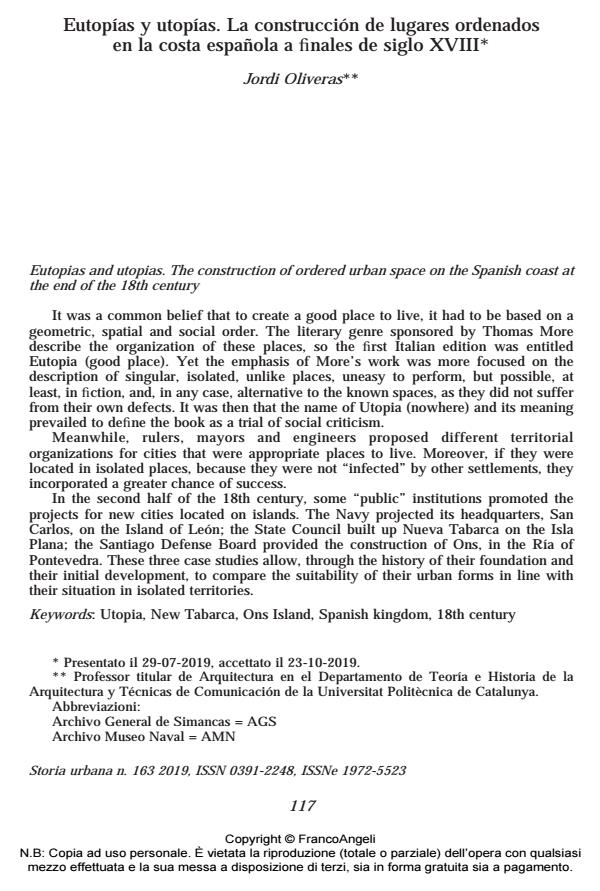Eutopias and utopias. The construction of ordered urban space on the Spanish coast at the end of the 18th century
Journal title STORIA URBANA
Author/s Jordi Oliveras
Publishing Year 2020 Issue 2019/163
Language Spanish Pages 23 P. 117-139 File size 394 KB
DOI 10.3280/SU2019-163007
DOI is like a bar code for intellectual property: to have more infomation
click here
Below, you can see the article first page
If you want to buy this article in PDF format, you can do it, following the instructions to buy download credits

FrancoAngeli is member of Publishers International Linking Association, Inc (PILA), a not-for-profit association which run the CrossRef service enabling links to and from online scholarly content.
It was a common belief that to create a good place to live, it had to be based on a geometric, spatial and social order. The literary genre sponsored by Thomas More describe the organization of these places, so the first Italian edition was entitled Eutopia (good place). Yet the emphasis of More’s work was more focused on the description of singular, isolated, unlike places, uneasy to perform, but possible, at least, in fiction, and, in any case, alternative to the known spaces, as they did not suffer from their own defects. It was then that the name of Utopia (nowhere) and its meaning prevailed to define the book as a trial of social criticism. Meanwhile, rulers, mayors and engineers proposed different territorial organizations for cities that were appropriate places to live. Moreover, if they were located in isolated places, because they were not "infected" by other settlements, they incorporated a greater chance of success. In the second half of the 18th century, some"public"institutions promoted the projects for new cities located on islands. The Navy projected its headquarters, San Carlos, on the Island of León; the State Council built up Nueva Tabarca on the Isla Plana; the Santiago Defense Board provided the construction of Ons, in the Ría of Pontevedra. These three case studies allow, through the history of their foundation and their initial development, to compare the suitability of their urban forms in line with their situation in isolated territories.
Secondo un concetto comune, un buon luogo per vivere doveva essere organizzato in base a un ordine geometrico, spaziale e sociale. Il genere letterario avviato da Tommaso Moro si proponeva il fine di descrivere questi nuovi spazi abitativi, per tale ragione nella prima edizione italiana prese il titolo di "Eutopia (buon luogo)". Tuttavia, l’opera di Moro poneva una particolare enfasi alla collocazione di un insediamento ideale in un luogo isolato appartato dal resto della comunità civile, per evitare di esse re contaminato dai suoi aspetti negativi. Un progetto di difficile realizzazione, ma possibile sul piano letterario. Fu allora che il nome Utopia (nessun luogo) e il significato in esso rappresentato prevalse per definire il genere letterario come una forma di critica sociale. Nel frattempo, sovrani, istituzioni municipali e ingegneri proposero diverse soluzioni per città che fossero luoghi appropriati da abitare. Soprattutto i luoghi isolati, lontani da altri centri abitati che avrebbero potuto contaminarli, si riteneva potessero rappresentare maggiori possibilità di successo per questi nuovi progetti. Nella seconda metà del XVIII secolo furono elaborate diverse proposte per nuovi insediamenti collocati su isole. Questi progetti avevano la peculiarità di essere proposti da organismi "pubblici". La marina militare realizzò il suo quartier generale a San Carlos sull’isola di León. Il Consiglio di Stato promosse la realizzazione di Nueva Tabarca sull’Isola Plana; la Junta de Defensa de Santiago costruì Ons, nell’estuario di Pontevedra. L’articolo si propone un’analisi comparativa di queste diverse esperienze insediative, attraverso l’esame del loro percorso insediativo e i primi sviluppi iniziali, per valutare la capacità di soddisfare gli auspici progettuali.
Keywords: Utopia, New Tabarca, Ons Island, Spanish kingdom, 18th century
Jordi Oliveras, Eutopías y utopías. La construcción de lugares ordenados en la costa española a finales de siglo XVIII in "STORIA URBANA " 163/2019, pp 117-139, DOI: 10.3280/SU2019-163007